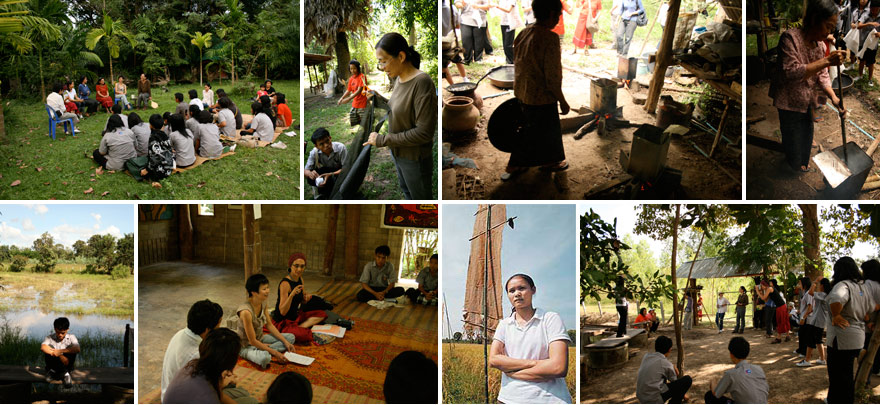7th Edition of Souvenir of Tucumán – Nomadic Anthology of Objects An Itinerant investigation of local knowledges 1997 – 2010 Project and environmental installation by Graciela Ovejero, with the participation of 89 artists from Tucumán, Argentina, and 20 art students from Isarn, Thailand. …because we are all inscribed in history our personal memories are connected to larger narratives of memory that are collectively shared at various degrees, processed and confirmed also at various degrees of officiality, consciousness and communication. In this process, all production, selection and display of imagery is an intrinsic aspect of identity construction between traditions and creativity, both at personal and social levels.
The conceptual core of this project is an open investigation of memories, local knowledge and the flux of identity as related to place, in the context of piercing globalization and generational gaps. This investigation first took place in 1997, in Tucumán Argentina, my place of origin, through an invitation for local artists to produce and object/souvenir reflecting their memory and ideas about Tucumán. In this way the Nomadic Anthology of Objects was formed. I have traveled with those objects (91) or images of them, carrying the same questions presented to the artists of Tucumán in the context of workshops and conversations, creating different installations in dialogue with local materials and themes, sometimes including contributions of artists and other people in the places of arrival.
In this case, a workshop with a group of art students and contributions by friends have provided some snap shots to pair printed images of the souvenirs from Tucumán, along with my own register of the visit and experience in this region of Thailand. The images, displayed on banana leaves, were hanging from the ceiling of a bamboo hut structure built in the garden of the Residency compound, in observation of traditional architecture and shapes that are being gradually replaced by more standard concrete forms. The hut, crossed with the skeleton of a large boat, also built with bamboo, is conceived both as a sacred space to house the postcards and as a sculpture. Hut and boat conform an outlined spatial system integrating female and male symbols, groundedness and mobility as aspects of culture and individual identities, placed in the direction East-West. The postcards hanging inside were visible from all angles of the open structure and translucent fishnet roof, yet inaccessible for scrutiny, as in the case of relics –also a present tradition in the context of Theravada national form of Buddhism–, configuring a sort of mobile that resembles the display of goods in many of the local craft shops.
Spirit Houses, are a visible presence in the gardens and house fronts throughout Thailand, a bit as in the random case of plaster goblins and flamingos in the west, but with a lot more symbolic gravitation and reverence. They are table top size and larger replications of temples, at times clearly demonstrating the level of wealth of the household, placed on a column that elevates them at eye level. Dedicated to the spirits of nature, their purpose is to protect the house and its inhabitants. They tend to be very colourful and are regularly cleaned up and ornamented with flowers as remainings of timeless animism.
Not knowing before hand what final format would result from the interaction with the community and students and dialogical aspects of my work, I was deeply inspired by the daily effort of human doings in the midst of a natural setting of powerful dynamics and abundant materiality, which demands constant work. I decided to build a distinct sacred space to dialog and contrast nature, noticing later on that the farm, exceptionally, did not actually have a spirit house
The installation as a complete work lasted just one full moon night and the next sunny day of open studios sharing event with community artists, journalists and various groups of students and children from near by villages. This took place on the 13th and 14th of November, in the context of celebrating the conclusion of the 5 weeks residency and the art projects conceived during it.
I have dedicated the piece to the whole family of Boonbandarn Farm where the Womanifesto Residency took place, a family of artists farmers, and particularly to Khun Mae (Pan Parahom) and Khun Pou (Boonjan Parahom), the elders who’s life efforts and personal visions have made the place come to existence. On the afternoon of the last day of residency, open to public, all the images hanging inside the memory-boathouse were given to the visitors as souvenirs, leaving the space vacant for new memories and functions. Graciela Ovejero. Boonbandarn Farm, November 2008.
Especial thanks to: all members of Boonbandarn family for their generosity sharing their home and knowledge, Womanifesto organizers for their diligent work, commitment and vision, to participating artists for their attentive companionship, to both workshop participating students and their enthusiastic teachers, Phaptawan Suwannakudt for near constant interpretations and translations between Thai and English, to Pi Nong Lak, Chian, Mae Tume, Jeep, Duang, Pan, Run and On-anog Glinsiri, for their help and assistance at various moments of the work process.
Born in I San Miguel de Tucumán, Argentina, Graciela Ovejero obtained a Master in Fine Arts from the University of California in San Diego, a Licenciatura en Artes Plásticas from National University of Tucumán/U.N.T. and a Professorship in Classical Dance. Graciela has participated in various group exhibitions since 1976, produced 29 individual shows and installations in museums and galleries of Argentina, Mexico, USA, Japan, Spain and Pakistan. She works and lives in and between California and the North-west of Argentina.








